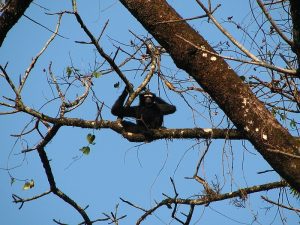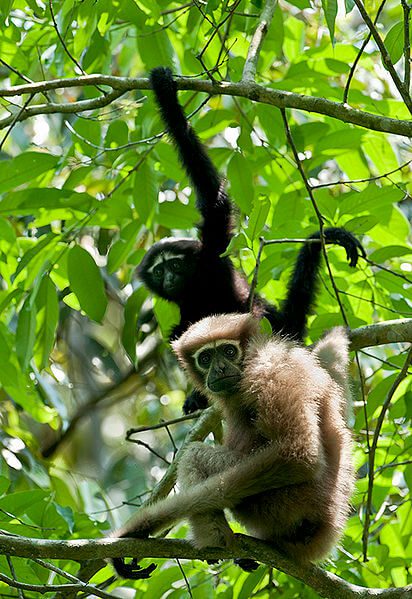Radhika was part of the rescue and rehab mission, in Arunachal Pradesh, for Hoolock Gibbons, facing extinction. Here’s a heart-wrenching appeal from her, exclusively for Different Truths.
 You look into the distant fields as your lone and loud calls echo through the valley. With fingers that are long and slender, meant for climbing, swinging, plucking, grabbing and arms that are strong and hang well below the knees. Your legs are short and clumsy, when on the ground, making it hard for you to run fast enough when danger lurks. I see you looking around nervously, waiting to hear an answering call from another one of your species but there is none. Loneliness is a great teacher, one that opens the windows toward self-awareness for its student.
You look into the distant fields as your lone and loud calls echo through the valley. With fingers that are long and slender, meant for climbing, swinging, plucking, grabbing and arms that are strong and hang well below the knees. Your legs are short and clumsy, when on the ground, making it hard for you to run fast enough when danger lurks. I see you looking around nervously, waiting to hear an answering call from another one of your species but there is none. Loneliness is a great teacher, one that opens the windows toward self-awareness for its student.
But what could it possibly teach you?
So completely enslaved are we by false advertising and societal conditioning, we do not even realise how trapped we are in our in self-imposed cages.
You, who have mastered the ways of nature, weathered the different seasons, learnt the meaning of the direction of the winds, raised generations to inhabit the forest and most importantly never forgotten the ways of the wild. Unlike us humans, who moved away from nature, searching for completeness in the fast-paced monotony of city lives and 9 to 5 jobs. Eating fast food under fluorescent light bulbs, reading fake news and feeling disconnected. So completely enslaved are we by false advertising and societal conditioning, we do not even realise how trapped we are in our in self-imposed cages. Because breaking through and stepping out, now feels scary and alien. But the few courageous ones will still venture and show the ways for others to follow. Until whole masses realise that where they truly belong is in nature. That will be the beginning of a new earth.
Hoolock Gibbons Face Extinction
The Hoolock Gibbons, the only non-human apes found in the sub-continent, are in grave danger of extinction due to increasing deforestation. Their homes are being destroyed at a ruthless pace. As forests are turned into fields, factories, plantations and villages across Assam and Arunachal, these gibbons and their families are left stranded in clumps of small trees, barely able to survive on the minimal food and as a result fall prey to hunting as they descend to the ground. Hoolock Gibbons use contiguous forest canopy to move, and the lack of adequate forest cover forces them to come down to land, putting their lives at risk.

This account is from my visit to Kamlang Wildlife Sanctuary in Arunachal Pradesh, where I saw families of Hoolock Gibbons stranded on a few trees with no escape route.
This account is from my visit to Kamlang Wildlife Sanctuary in Arunachal Pradesh, where I saw families of Hoolock Gibbons stranded on a few trees with no escape route. Our team of conservationists helped capture several small families of gibbons and moved them to a safe location in Kamlang Wildlife Sanctuary. Their activity was closely monitored post release to ensure their survival in the wild. The capture operation was undertaken in Wakro. where thousands of acres of rain forests were being cleared by local communities for agriculture. How I lamented the loss of those forests and the short-sighted ignorance of these people, who were unknowingly destroying the most precious gifts to them from mother nature.
A Family of Gibbons Captured for Rehab
I watched as a family of three gibbons was captured by us one by one in an agricultural field, which had been a lush forest, just a few days ago. The gibbons were forced down the trees by local tribesmen selected for the operation and were caught using baskets as soon they jumped on the ground. They were then sedated and examined by vets to ensure minimal stress and ensure their health status. Looking at them up close was an experience, which is a beautiful way reinforced my feeling of oneness with nature. As the female lay unconscious, I closely observed her hands, so similar to human hands, her delicate eyes closed, shutting out the world and all its injustice. We are like brothers and sister born from the earth and will return to the earth one day. How can we accept the wrongs done to her and her small family and their beautiful home in the forest? Surely it stirs something deep within you, which may give me hope for our future.
The juvenile male regained consciousness first while his mother and father were still groggy with drugs.
The juvenile male regained consciousness first while his mother and father were still groggy with drugs. He vocalised his anger and fear equally at me through the cage bars. Early the next morning, we took the three cages up a small hill in the Kamlang Sanctuary and released the gibbons, who almost instantly disappeared in the thick jungle.
I remember this and see them as refugees, thrown out of their homes, threatened by act of violence against them and then rehabilitated in “safer for now” locations. Perhaps we live in fantasy, imagining that these animals will be there forever, and the sounds of their calls will bring the jungles alive every morning.
Marconi became convinced that sound never dies.
This reminds me of a story I had read, of the inventor and radio pioneer, Guglielmo Marconi, who once imagined he could listen back through time. In his 60s, having suffered a number of heart attacks, he dreamed “of a device that would let him hear lost sounds, let him tap into these eternal frequencies. Marconi became convinced that sound never dies. He imagined how wonderful it would be to hear Mozarts first symphony played for the first time, the sound of your lover telling you they love you for the first time, hear your first child’s first cry after being born. Hear everything, ever said, forever.

But this of course was a futile dream and the sounds we hear are lost forever in the fabric of space and time. Such seems to be the fate of these gibbons too, with our expanding apathy, their calls echoing through the forest will one day haunt us forever, never to be heard again.
Photos and video sourced by the author from the Internet





 By
By
 By
By
 By
By